Punjab State Board PSEB 7th Class Physical Education Book Solutions Chapter 3 Posture and Its Deformities Textbook Exercise Questions and Answers.
PSEB Solutions for Class 7 Physical Education Chapter 3 Posture and Its Deformities
Physical Education Guide for Class 7 PSEB Posture and Its Deformities Textbook Questions and Answers
Question 1.
What is meant by body posture? How does our body stand on both legs?
Answer:
Posture may imply the proper care of the structure of the body. A good posture is one that has less pressure on different organs of the body and by which these organs may remain at ease and do the maximum work. In case the posture is not kept right, many deformities arise in the body. If we try to arrive at the precise definition of posture, the uppermost thought in our mind is that we have to keep our body in such a way that keeps balance among all the different organs of our body.
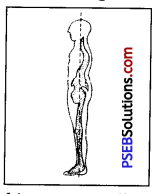
Posture is indeed, deeply related to human body. The person who.does not pay attention to his posture suffers from many weakness and deformities small children should be asked to give proper attention to posture in childhood itself so that they may not become prey to the posture related deformities and weakness and may lead a healthy and comfortable life. A good & balanced posture is the relative correct position of various parts of our body.
A person with good and balanced posture looks natural & graceful in his positions of standing, sitting, walking, sleeping & reading. When weight of upper parts of body is uniformly distributed on lower parts of body, a line may be drawn from the head to foot, indicating-the weight line. This weight line starts from uppermost part of the head & goes down at the level of knees. It starts from the end of the skull & passing through vertebrae of back it passes through the hip, knee and ankle & goes downward. In this way, the weight of the parts of the body is uniformly disturbed from the top of the bottom.
![]()
Question 2.
What are the qualities of a good posture?
Answer:
- We have to spend less energy by possessing balance posture.
- Movements become very easy.
- Balance posture influence others.
- A person possessing good posture develop self-confidence.
- Very active and clever in all daily work.
- Good posture does not put pressure on bones or muscles.
Question 3.
What are the benefits of having a good posture?
Answer:
Good health is the first precondition of good body posture. A straight & balanced body is beautiful to look at. It gives a good impression to others and one feels good about oneself whereas people make fun of a man with asymmetrical body. So having a good symmetrical body.
A straight & balanced body puts less pressure on the muscles because the weight is balanced and equally divided between front & back muscles. If the posture is good internal organs work properly without any problem. It is easier for a man to achieve good posture without much effort, when he is young, say, till the age of twenty.
![]()
Question 4.
How are deformities formed in the body posture? Write down the main deformities of the body.
Answer:
1. Vocation:
A person sits, get up, walk according to the nature of work such as sitting work or standing work or some type of work, so his body parts change their nature of working eg. a person who has to work sitting in chair with the head down his body take the shape according to his sitting posture.
2. Nutritious food:
For the better physical structure and nourishment, a nutritious food is not taken, the body structure & development are badly affected. In the lack of calcium, bones become bending towards one side.
3. Bad habits:
Bad postures are also affected by mimic activities of bad posture persons are not balancing at the time of walking, getting up & running.
4. Proper Dress: Our body is stressed due to tight clothes, boots, pants, shirts so our dress should be proper.
5. Over weight: Body also feels abnormal due to over weight & wears bad posture.
6. Due to Injury: Walking is also effected by some injury & body bears bad posture.
Physical deformities:
- Kyphosis
- Lordosis
- Scoliosis
- Having both kyphosis & Lordosis
- Knock knees
- Flat foot
- Depressed chest
- Pigeon shaped chest
- Flat chest
- Bent neck.
![]()
Question 5.
Give the reasons of kyphosis. What are the exercises recommended to correct the deformity?
Answer:
It is a type of curvature, he neck leans forward & backward. In kyphosis the spinal cord bends in the shape of bow. The chest cannot remain erect. This condition in a boy develops due to continuous sitting for hours in one incorrect posture. If the fault is correct indue time the backbone comes to its right position. In case the back gets completely bent, it becomes difficult to bring it back to its right position. The improper posture creates kyphosis, as a result of which heart & legs donot function properly.
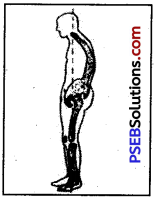
Causes:
- Reading in dim light, while bending forward.
- Short eye sight.
- Head of hearing.
- Use of worthless furniture for sitting.
- Wearing tight & shapless clothes.
- Weakening of muscles by less or no exercise.
- Quick development of body.
- Sickness or accident.
Prevention:
- Keeping the straight body while doing daily activities walking, sitting & standing.
- The chin should be up. The chest forward & heat straight.
- While resting on the back of the chair the head should be bent back with the eyes looking straight forward.
- Deep breathing exercises should be alone.
- Push ups, swimming & other chest exercises should be done.
- Back shoulders should be supported by pillow.
- Hanging from walls bars. The back should be towards the wall bars.
![]()
Question 6.
Give the reasons of lordosis. What exercises are recommended to correct the deformity?
Answer:
Causes:
- The habit of walking with belly protruding in younger age.
- Not taking balanced diet in chilhood.
- Taking excessive food.
- Women’s giving birth to many children.
- Not doing exercise.
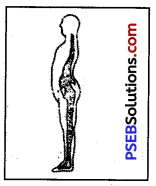
Preventions:
- Standing fully erect, bending the trunk forward & then straightening.
- Lying on the back and then raising. Head & legs turn by turn.
- Lying on the back, rising & again lying.
- Practising ‘hal-asana’.
- Standing attentively & touching the feet with hands again & again.
Question 7.
Why flat foot are formed? Give the recomended exercises for flat foot. Write down the method of finding out whether the foot is flat or not.
Answer:
If we look carefully at the sole of the feet, we find that there is an arch which goes upward toward toe. When the muscles of the feet become weak & lose, there arches lose their curvaciousness & the feet become flat. A flat foot cannot bear the bodv weight well. It causes pain. Runing & walking becomes difficult.
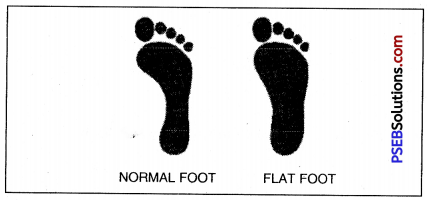
Reasons:
Lack of exercise, Obesity, standing for long hours wearing ill-fitting shoes, wrong and faulty body posture.
Test of flat foot-spread some soft & wet soil levelled on the ground. Then placing your foot on it & move forward. If the foot is normal, it will look like the foot in figure. The figure makes it clear that the inner portion of the sole of the normal foot does not touch the ground while the whole sole of the flat foot touches the ground because its aches have become straight.
Exercises:
- Walking & running on the toes.
- Walking & running slowly on heels.
- Cycling forcefully with toes.
- Climbing the stair bars.
- Dancing.
- Walking on heels & toes of foot.
- Walking on the slope of the triagular wooden board.
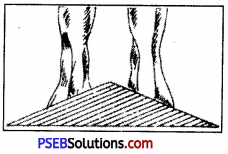
![]()
Question 8.
What deformities are formed in the chest bones? How can it be corrected?
Answer:
Depressed Chest: In this type of deformity the bones get pressed inward.
Flat Chest: In it the ribs instead of protruding carer gets flattened to the level of the chest bones.
Pigeon-Type Chest: In this type of deformity the chest bones get raised upward.
Causes:
- Not doing exercises regularly.
- Some dangerous diseases.
- Bending excessively forward while sitting, standing or walking.
- Deficiency of phosphorus, calcium & vitamin D.
Corrective Exercise:
- Cutting the fodder with hand driven toka.
- Practising breathing exercises.
- Doing arm & trunk exercises.
- Performing ‘dandas’ while hanging from a pole.
- Performing ‘dandas’.
Question 9.
Give the reasons for the following deformities. Also write down the exercises recommended for them:
1. Bent neck
2. Knock knees
3. Flat chest.
Answer:
1. Bent neck:
When the muscles on one side of the neck become weak & loose & those of the other side shrink, the neck turns on one side.
Reasons:
- Carrying the child only on one side.
- Making the infant lie on one side for long hours.
- Having weak eye-sight on one side.
- Bad posture while-studying.
2. Knock knees:
Deficiency of calcium, phosphorus & vitamin D can cause bent bones in small children. The lack of above nutrients make the bones weak & they cannot bear the body weight because of which the bones turn inwards. A person with knock knees cannot stand at attention. His knees knock with each other when he tries to put his feet together in the attention.
3. Flat Chest:
In it the ribs instead of protruding nearer gets flattened to the level of the chest bones. Depressed chest-In this type of deformity, the bones get pressed inward.
4. Pigeon-type Chest:
In this type of deformity the chest bones get raised upward. These deformities occur in early childhood, destructing the respiratory process.
![]()
Question 10.
Give a list of Good habits which help in having a good Posture.
Answer:
- Sufficient amounts of Calcium, Phosphorus & Vitamin D should be included in diet of children.
- The children should be given sun bath and massage at least twice a week.
- Eyesight should be got tested at regular intervals.
- It is not good to stand for a long time putting weight only on feet.
- Good quality furniture with proper shape and sufficient light should be provided for school-going children.
- Breathing exercises should be done daily.
- Narrow-fitting clothes and shoes should not be worn.
- Exercises should be done regularly.
- Specific exercise for the particular problem of the posture should be done as per requirement.
Question 11.
Explain about Lordosis.
Answer:
Lordosis is a different type of curvature from kyphosis. In this type of defc nity the spine is bent not from the upper side, but it leans forward from the stomach. Lordosis can be checked at an early stage. It is not possible to rectify it at a later stage.
Exercises Related to Lordosis:
1. Bend knees forward while allowing hips to bend back behind, keeping back straight and knees pointed in same direction as feet. Descend until thighs are just parallel to floor. Extend knees and hips until legs are straight. Come back in starting position and then repeat the same.
2. Lie down in prone position, with hands under abdomen. Then keep hips and shoulders down, press hands up on abdomen and raise lower back.
3. Sit on a chair with feet wide apart. Bend and position your shoulders between knees. Then reach to the floor under back of chair, and hold this position for some duration.
4. Lunge forward with knee on a mat. Take position of the foot beyond knee. Place both hands on knee. Straighten hips of rear leg by pushing hips forward and hold stretch. Repeat with opposite side.
5. Sit down with knees extended, feet together and hands at sides. After that bend forward, touching the fingers to toes. Hold this position for some time. Then come back and repeat.
6. Lie in prone position on the floor. Keep the palms of your hands on the floor according to shoulders’ width. Push torso up keeping pelvis on floor. Hold this position for some time.
![]()
PSEB 7th Class Physical Education Guide Posture and Its Deformities Important Questions and Answers
Multiple Choice Questions
Question 1.
What are the benefits of good posture?
(A) Good looking body
(B) Running, activeness
(C) Healthy body
(D) All the above.
Answer:
(A) Good looking body
Question 2.
Deformities of the body:
(A) Kyphosis
(B) Lordosis
(C) Scoliosis
(D) All the above.
Answer:
(D) All the above.
Question 3.
Causes of Kyphosis:
(A) Weak eye sight
(B) Hard hearing
(C) Sickness or accident
(D) All the above.
Answer:
(D) All the above.
Question 4.
Method of corrective of Kyphosis.
(A) Keeping the straight body
(B) The Chin should be up
(C) Deep breathing exercises should be done
(D) All the above.
Answer:
(D) All the above.
![]()
Question 5.
Reasons of Lordosis:
(A) No taking balance diet in Childhood
(B) Taking excessive food
(C) No doing exercises
(D) All the above.
Answer:
(D) All the above.
Question 6.
Pretention of Lordosis Corrective.
(A) Standing fully or erect, bending the trunk forward
(B) Lying on the back and then moving head and legs turn by turn
(C) Lying on the back rising and again lying
(D) All the above.
Answer:
(D) All the above.
Question 7.
Exercises to removed the flatrfoot.
(A) Walking and running on the toes
(B) Walking and running on heels
(C) Climbing the stairs bar
(D) All the above.
Answer:
(D) All the above.
Very Short Answer Type Questions
Question 1.
After how long a person derived the posture of standing on both legs?
Answer:
After lakhs of years.
![]()
Question 2.
What is attached to the after and before of bones?
Answer:
Muscles.
Question 3.
If the Muscles don’t have co-ordination and balance then what happens?
Answer:
Body bends forward.
Question 4.
How the straight body looks?
Answer:
Beautiful.
Question 5.
At what age body posture becomes good and bad?
Answer:
20 years.
Question 6.
What steps should be taken to keep the body fit?
Answer:
Exercise.
Question 7.
Which type of foot cannot bear the weight of the body?
Answer:
Flat foot.
![]()
Short Answer Type Questions
Question 1.
Define body posture.
Answer:
If the body frame is straight and in good shape and if the lower part of the body balances the upper part well, it can be called a good body posture.
Question 2.
what deformities are formed in chest?
Answer:
- Depressed chest
- Pigeon chest
- Flat chest
